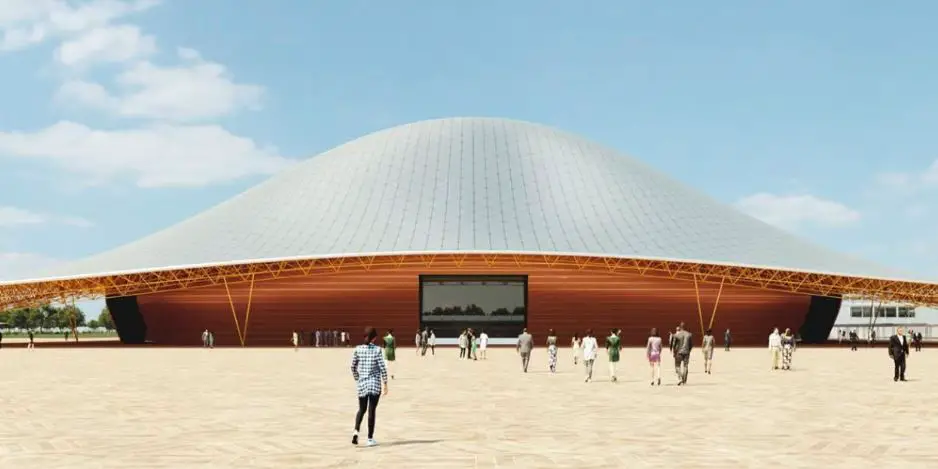Ivory Coast’s Giant Exhibition Center Will Turn Into Regional Hub
An ambitious Exhibition Center project is projected to turn Ivory Coast into a regional hub that can host various forms of gatherings including both international, regional and local.
The Parc des expos is located in the south of the Abidjan city on the road to Félix Houphouët Boigny International Airport.
It was thought up and initiated by the late Prime Minister Amadou Gon Coulibaly when he was considering taking the oath there if he had been elected President of the Republic.
Its most obvious interest is to provide adequate spaces to host major international conferences, trade fairs and certain sporting events.
The Sofitel Ivoire convention center in Abidjan, with its 1,300-seat room, has become too cramped.
The new complex is developed by the PFO Africa group and its partners – including the Belgian Besix, the French JL Event and Vinci Énergie and several other companies including Solid and Gagne – for an estimated amount of 53 billion CFA francs,
There are six priority projects for the transformation of Abidjan city.
The government of Prime Minister Patrick Achi has validated the new national development program (PND) for the period 2021-2025.
This ambitious plan provides for investments of more than €90 billion, primarily in modern infrastructure that will initiate the structural change of the country.
This plan takes up the various projects that had not been carried out during the previous two five-year terms.
The completion of the PND seeks to promote a strong recovery in growth to 8% for the period 2021-2025. In Abidjan, the nerve center of the national economy is undergoing major transformations. Several large-scale projects are underway to provide the city with modern infrastructure.
The Abidjan port platform is under construction.
One of the challenges of Hien Sié, general manager of the port, is to make it attractive and competitive.
“We are accelerating investments. Our problem is mainly related to port congestion. The boulevard that crosses the enclosure is now outdated. It was built in the 1960s, when the port was carrying traffic of 4 million tonnes,” explains Hien Sié.
The competitiveness of the port remains a problem. The congestion of this logistics platform impacts its performance. To remove all its obstacles, Abidjan is stepping up projects and wants to remain the main port in the Gulf of Guinea and a hub, despite increased investments in competing sites of Tema in Ghana, Lomé in Togo or Kribi in Cameroon.
This vast plan provided, among other things, for the widening and deepening of the Vridi Canal, the main entry route, to allow access for large merchant ships.
This logistical jewel of more than 727 billion CFA francs will reposition Abidjan as one of the hubs on the Atlantic coast of Africa, between Tangier in Morocco and Durban in South Africa. The installed capacity of 1.5 million container handling will double to 3 million TEU per year, but still far from Tema and its 3.7 million TEU.
The port is pursuing its strategy of specializing its quays, with a view to making handling activities and operations more fluid. The construction site for the ro-ro terminal dedicated to bulk imports and exports has been delivered. Other projects, such as the grain wharf carried by the Japanese, are in progress.
The metro wants to start
This flagship project of the Head of State Alassane Ouattara since his first term will be operational by 2025 at the latest.
This is the wish of the current Prime Minister Patrick Achi, who has mobilized all his teams to overcome the difficulties and move forward. The government has moved to speed up the compensation process.
“The compensation is ready, we could not clear the rights of way during the past school year. We waited for the holidays to start the process”, explained Patrick Achi, who visited the section of line 1 last August.
The electricity sector in catch-up mode
The last energy crisis from March to June highlighted the fragility and precarious balance of the electricity sector.
President Alassane Ouattara’s objective of reaching 40,000 megawatts of production capacity by 2020, announced when he came to power in 2011, has not been achieved.
The capacity is 2,230 MW. Extension projects for the two largest thermal power plants in the country are underway.
The first, operated by the British Globeleq in its phase IV, will increase its power to more than 253 MW on its Yopougon Azito site. And Ciprel V, from the French Eranove, will build a power plant in the Jacqueville region with an installed capacity of 390 MW.
These two extension projects, which will bring a surplus of more than 650 MW to national production, will require an investment of more than 500 billion CFA francs, the financing of which has already been finalized. Under pressure, Thomas Camara, the Minister of Petroleum, Mines and Energy, visited the two sites.
“These thermal power stations will be powered by natural gas,” he explains. It is important that we ensure that when these plants are about to start up, the gas is available, ready to supply them.




















